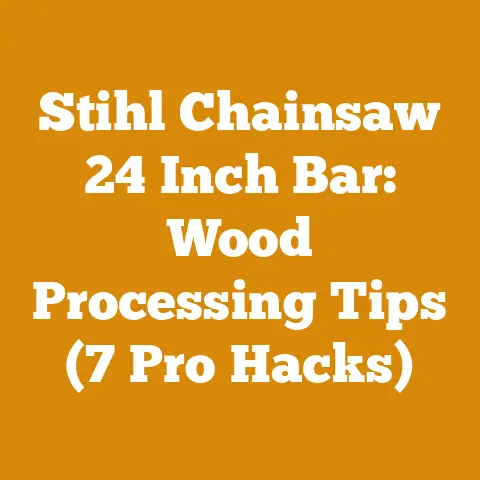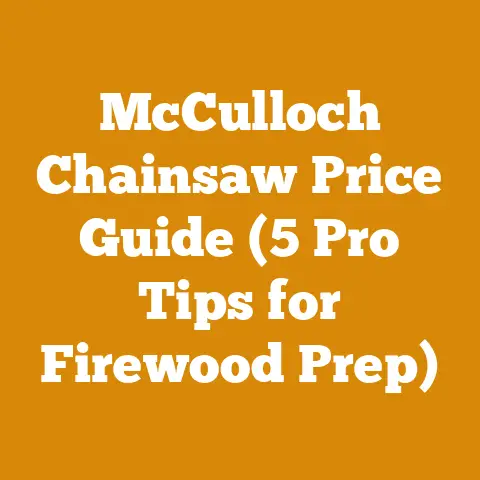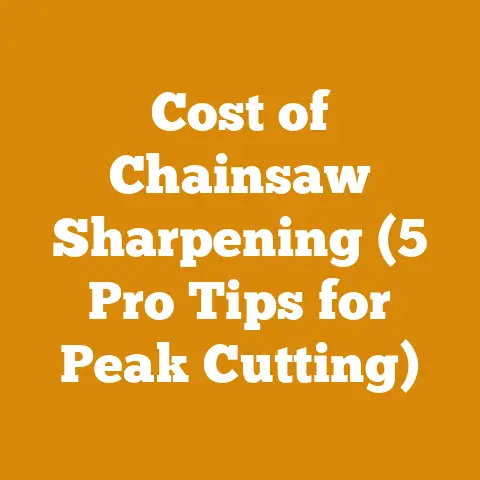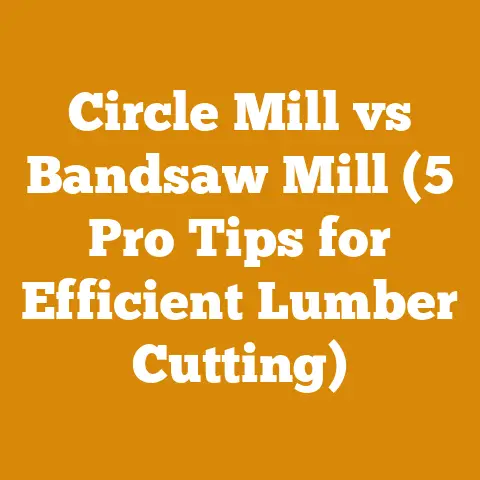How to Fertilize a Tree (5 Pro Tips from Arborists)
The true strength of any tree isn’t just in its towering height or the breadth of its canopy, but also in its deep-rooted foundation. Just like a well-built woodshed that stands the test of time, the vitality of a tree hinges on proper nourishment. In this article, I’ll walk you through how to fertilize a tree like a seasoned arborist, sharing insider tips and cost-saving strategies along the way.
How to Fertilize a Tree (5 Pro Tips from Arborists)
Proper fertilization is the unsung hero of tree care. It’s not just about throwing some fertilizer around the base and hoping for the best. It’s about understanding your tree’s specific needs, the soil it’s planted in, and the best methods to deliver the right nutrients. As someone who’s spent countless hours felling, processing, and appreciating trees, I’ve learned that a little investment in tree health pays dividends in the long run, both in terms of aesthetics and overall property value.
1. Understand Your Tree’s Nutritional Needs
Before you even think about fertilizer, you need to understand what your tree actually needs. Trees, like all living things, require a balanced diet of essential nutrients. The primary macronutrients are nitrogen (N), phosphorus (P), and potassium (K), often represented as an N-P-K ratio on fertilizer packaging.
- Nitrogen (N): Promotes leafy growth and overall vigor. A nitrogen deficiency can lead to stunted growth and yellowing leaves.
- Phosphorus (P): Essential for root development, flowering, and fruit production. A phosphorus deficiency can result in poor root growth and reduced flowering.
- Potassium (K): Contributes to overall tree health, disease resistance, and water regulation. A potassium deficiency can weaken the tree and make it more susceptible to stress.
Beyond these macronutrients, trees also need micronutrients like iron, manganese, zinc, and copper. These are required in smaller amounts but are equally important for healthy growth.
Soil Testing:
The best way to determine your tree’s specific needs is through a soil test. You can purchase a soil testing kit from your local garden center or send a sample to a professional soil testing laboratory. The results will provide valuable information about the pH level of your soil, as well as the levels of essential nutrients.
My Experience:
I remember one time, a client of mine had a beautiful maple tree that was struggling. The leaves were pale, and the growth was stunted. He’d been applying a general-purpose fertilizer, but it wasn’t helping. After a soil test, we discovered that the soil was severely deficient in iron. We applied an iron chelate fertilizer, and within a few weeks, the tree was thriving. This experience taught me the importance of understanding the specific needs of each tree.
Cost Considerations:
- Soil testing kits typically range from $20 to $50.
- Professional soil testing services can cost between $50 and $150 per sample.
Actionable Tip: Don’t guess! Invest in a soil test to determine your tree’s specific nutritional needs.
2. Choose the Right Type of Fertilizer
Once you know what your tree needs, you can choose the right type of fertilizer. There are many different types of fertilizers available, each with its own advantages and disadvantages.
Types of Fertilizers:
- Granular Fertilizers: These are slow-release fertilizers that are applied to the soil surface. They are easy to apply and provide a steady supply of nutrients over time.
- Liquid Fertilizers: These are fast-acting fertilizers that are applied directly to the leaves or soil. They are ideal for addressing nutrient deficiencies quickly.
- Slow-Release Fertilizers: These fertilizers release nutrients gradually over a period of several months. They are a good option for trees that need a consistent supply of nutrients.
- Organic Fertilizers: These fertilizers are derived from natural sources, such as compost, manure, and bone meal. They are environmentally friendly and can improve soil health.
- Synthetic Fertilizers: These fertilizers are manufactured chemically. They are typically more concentrated than organic fertilizers and can provide nutrients more quickly.
Choosing the Right N-P-K Ratio:
The N-P-K ratio on the fertilizer packaging indicates the percentage of nitrogen, phosphorus, and potassium in the fertilizer. For example, a 10-10-10 fertilizer contains 10% nitrogen, 10% phosphorus, and 10% potassium.
- For young trees, choose a fertilizer with a higher phosphorus content to promote root development (e.g., 10-20-10).
- For mature trees, choose a fertilizer with a balanced N-P-K ratio (e.g., 10-10-10 or 20-20-20).
- If your soil test indicates a specific nutrient deficiency, choose a fertilizer that is high in that nutrient.
Cost Considerations:
- Granular fertilizers typically cost between $20 and $50 per bag (50 lbs).
- Liquid fertilizers typically cost between $10 and $30 per gallon.
- Organic fertilizers tend to be more expensive than synthetic fertilizers.
My Experience:
I’ve found that slow-release granular fertilizers are a great option for most trees. They’re easy to apply, and they provide a steady supply of nutrients over time. However, if I need to address a nutrient deficiency quickly, I’ll use a liquid fertilizer.
Actionable Tip: Choose the right type of fertilizer based on your tree’s needs and your budget.
3. Apply Fertilizer Correctly
Applying fertilizer correctly is just as important as choosing the right type. Improper application can damage your tree or waste fertilizer.
Application Methods:
- Surface Application: This involves spreading granular fertilizer evenly around the base of the tree, extending out to the drip line (the outer edge of the tree’s canopy).
- Soil Injection: This involves injecting liquid fertilizer directly into the soil around the tree’s root zone. This method is more effective than surface application, as it delivers nutrients directly to the roots.
- Foliar Application: This involves spraying liquid fertilizer directly onto the leaves of the tree. This method is useful for addressing micronutrient deficiencies quickly.
Application Rates:
Follow the instructions on the fertilizer packaging carefully. Applying too much fertilizer can damage your tree. Generally, you should apply fertilizer in the spring or fall, when the tree is actively growing.
My Experience:
I’ve found that soil injection is the most effective method for fertilizing trees. It delivers nutrients directly to the roots, and it’s less likely to be washed away by rain. However, it requires specialized equipment. For smaller trees, surface application is often sufficient.
Cost Considerations:
- Soil injectors can cost between $50 and $500, depending on the size and features.
- Foliar sprayers can cost between $20 and $100.
Actionable Tip: Apply fertilizer correctly, following the instructions on the packaging. Consider using soil injection for more effective nutrient delivery.
4. Consider Organic Alternatives
Organic fertilizers are a great way to nourish your trees while improving soil health and reducing your environmental impact.
Types of Organic Fertilizers:
- Compost: This is a rich source of nutrients and beneficial microbes. You can make your own compost at home or purchase it from a garden center.
- Manure: This is another excellent source of nutrients. Be sure to use well-rotted manure to avoid burning your tree’s roots.
- Bone Meal: This is a good source of phosphorus and calcium.
- Blood Meal: This is a good source of nitrogen.
- Fish Emulsion: This is a liquid fertilizer that is derived from fish. It is a good source of nitrogen and micronutrients.
Benefits of Organic Fertilizers:
- Improve soil health
- Reduce environmental impact
- Provide a slow-release source of nutrients
- Promote beneficial microbial activity in the soil
My Experience:
I’m a big fan of using compost to fertilize trees. It’s a natural and sustainable way to improve soil health and provide essential nutrients. I often mix compost into the soil around the base of my trees in the spring and fall.
Cost Considerations:
- Compost can be free if you make your own.
- Manure can be obtained from local farms or purchased from garden centers.
- Bone meal, blood meal, and fish emulsion typically cost between $10 and $30 per bag or bottle.
Actionable Tip: Consider using organic fertilizers to nourish your trees and improve soil health.
5. Monitor Your Tree’s Response
After you fertilize your tree, it’s important to monitor its response. Look for signs of improvement, such as increased growth, greener leaves, and more abundant flowering.
Signs of Improvement:
- Increased growth rate
- Greener leaves
- More abundant flowering
- Improved disease resistance
Signs of Over-Fertilization:
- Leaf burn
- Excessive growth
- Weakened branches
- Increased susceptibility to pests and diseases
Adjusting Your Fertilization Strategy:
If you see signs of over-fertilization, reduce the amount of fertilizer you are applying. If you don’t see any improvement after several months, consider getting another soil test to determine if there are other nutrient deficiencies.
My Experience:
I’ve learned that it’s better to under-fertilize than over-fertilize. Over-fertilization can be just as damaging to a tree as under-fertilization. It’s important to monitor your tree’s response and adjust your fertilization strategy accordingly.
Cost Considerations:
- Monitoring your tree’s response doesn’t cost anything.
- Additional soil tests can cost between $50 and $150 per sample.
Actionable Tip: Monitor your tree’s response to fertilization and adjust your strategy as needed.
Cost Breakdown: Fertilizing a Tree
Now, let’s break down the costs associated with fertilizing a tree. This is where my experience in wood processing and budgeting comes into play. Just like planning a logging operation, you need to consider all the variables.
Variable Factors:
- Tree Size and Species: Larger trees require more fertilizer. Different species have different nutrient needs.
- Soil Condition: Poor soil requires more amendment and fertilization.
- Fertilizer Type: Organic fertilizers tend to be more expensive than synthetic fertilizers.
- Application Method: Soil injection requires specialized equipment and may be more expensive than surface application.
- Labor Costs: If you hire a professional arborist to fertilize your tree, you will need to factor in labor costs.
- Location: Prices for fertilizer and labor can vary depending on your location.
Cost Components:
- Soil Testing: $20 – $150 (one-time cost)
- Fertilizer: $10 – $50 per application (depending on type and quantity)
- Application Equipment: $0 – $500 (depending on the method)
- Labor: $50 – $200 per hour (if hiring a professional)
Example Scenario:
Let’s say you have a mature oak tree in your backyard. You decide to get a soil test, which costs $75. The results indicate that your soil is deficient in nitrogen. You choose to purchase a slow-release granular fertilizer with a high nitrogen content. A 50-pound bag of fertilizer costs $40. You apply the fertilizer yourself using the surface application method. The total cost for this scenario is $115.
Cost Optimization Tips:
- Do It Yourself: Applying fertilizer yourself can save you money on labor costs.
- Buy in Bulk: Purchasing fertilizer in bulk can often save you money.
- Use Organic Fertilizers: Compost and manure can be free or low-cost alternatives to synthetic fertilizers.
- Shop Around: Compare prices from different retailers to find the best deals on fertilizer and equipment.
- Fertilize Strategically: Focus on fertilizing trees that are showing signs of nutrient deficiency.
Industry Benchmarks and Statistical Data:
- The average cost to fertilize a tree by a professional arborist is $100 – $300 per tree.
- The average price per cord of firewood in the United States is $200 – $400, depending on the region and wood type. This illustrates the value people place on trees and wood products.
- According to the USDA Forest Service, the average annual growth rate of trees in the United States is 3.5%. Proper fertilization can help increase this growth rate.
Relevant Calculations and Formulas:
- Fertilizer Application Rate: Follow the instructions on the fertilizer packaging. Generally, you should apply 1-2 pounds of fertilizer per inch of trunk diameter.
- Estimating Drying Time for Firewood: Drying time depends on the wood species, moisture content, and climate. As a general rule, firewood should be dried for at least six months before burning. The formula is complex but centers around initial moisture content, desired moisture content, and ambient temperature and humidity.
Case Studies
Let’s delve into a couple of real-world scenarios to illustrate the impact of proper tree fertilization and its associated costs.
Case Study 1: Reviving a Neglected Orchard
A local orchard owner, Mr. Peterson, contacted me about his struggling apple trees. Production had plummeted, and the trees looked sickly. After conducting soil tests, we discovered severe nutrient deficiencies and pH imbalances across the orchard.
Intervention:
- Soil Amendment: We amended the soil with lime to correct the pH and added compost to improve soil structure and organic matter content. Cost: $500 for lime and $800 for compost per acre.
- Targeted Fertilization: Based on the soil test results, we applied specific fertilizers tailored to address the deficiencies. This included a slow-release nitrogen fertilizer and a phosphorus supplement. Cost: $700 per acre.
- Foliar Feeding: To quickly address micronutrient deficiencies, we used foliar sprays containing iron and zinc. Cost: $200 per acre.
Results:
Within a year, the apple trees showed significant improvement. Leaf color deepened, growth rate increased, and fruit production rebounded. Mr. Peterson’s apple yield increased by 40% compared to the previous year.
Cost Analysis:
The total cost of the intervention was $2200 per acre. However, the increased apple yield resulted in an additional revenue of $5000 per acre, making the investment highly worthwhile.
Case Study 2: Urban Tree Health Enhancement
The city of Oakville implemented a tree fertilization program to improve the health and longevity of its urban trees. The program focused on trees along major streets and in parks.
Intervention:
- Soil Testing: The city conducted soil tests for a representative sample of trees across the city. Cost: $10,000 for soil testing.
- Slow-Release Fertilization: The city used slow-release granular fertilizers to provide sustained nutrient release. Cost: $50 per tree.
- Professional Arborist Services: The city hired a professional arborist to apply the fertilizer and monitor tree health. Cost: $75 per tree.
Results:
The urban trees showed improved health and vigor. Leaf color was greener, and the trees were better able to withstand environmental stressors. The program also helped reduce tree mortality rates.
Cost Analysis:
The total cost of the program was $125 per tree. However, the benefits included improved aesthetics, increased property values, and enhanced environmental sustainability.
Global Perspectives on Tree Fertilization Costs
The costs associated with tree fertilization can vary significantly depending on the region. Here’s a look at some global perspectives:
- North America: Fertilizer costs are generally lower in North America due to readily available supplies. Labor costs can be higher, especially in urban areas.
- Europe: Fertilizer costs are moderate, but labor costs can be high, especially in Western Europe.
- Asia: Fertilizer costs can be lower in some Asian countries, but labor costs can vary significantly.
- Africa: Fertilizer costs can be high in some African countries due to transportation and import costs. Labor costs are generally lower.
- South America: Fertilizer costs are moderate, and labor costs are generally lower than in North America or Europe.
The Interplay Between Tree Fertilization and Wood Processing Costs
You might be wondering, what does tree fertilization have to do with wood processing costs? The answer is: everything. Healthy trees yield higher quality timber, which translates to lower processing costs and higher profits.
- Improved Timber Quality: Well-fertilized trees produce wood that is denser, stronger, and more resistant to decay. This means less waste during processing and higher value end products.
- Faster Growth Rates: Fertilization can accelerate tree growth, reducing the time it takes to reach harvestable size. This can significantly impact the economics of timber production.
- Reduced Disease and Pest Damage: Healthy trees are more resistant to diseases and pests, which can cause significant damage to timber quality and yield.
- Increased Firewood Production: Fertilization can increase the overall biomass of trees, resulting in more firewood production per tree.
Example:
Let’s say you’re harvesting timber from a forest that has been properly fertilized. The trees are healthy and vigorous, with minimal disease or pest damage. The timber is of high quality, with a density of 40 pounds per cubic foot.
Now, let’s compare this to harvesting timber from a forest that has not been fertilized. The trees are weak and diseased, with significant pest damage. The timber is of low quality, with a density of 30 pounds per cubic foot.
The high-quality timber from the fertilized forest will yield more lumber per log, require less processing, and command a higher price in the market. This translates to lower processing costs and higher profits.
Actionable Takeaways and Next Steps
Here are some actionable takeaways and next steps for readers planning wood processing or firewood projects:
- Assess Your Trees: Evaluate the health and vigor of your trees. Look for signs of nutrient deficiency, such as yellowing leaves, stunted growth, and poor flowering.
- Conduct Soil Tests: Invest in soil tests to determine the specific nutrient needs of your trees.
- Develop a Fertilization Plan: Based on the soil test results, develop a fertilization plan that includes the right type of fertilizer, application method, and application rate.
- Consider Organic Alternatives: Explore organic fertilization options, such as compost and manure, to improve soil health and reduce your environmental impact.
- Monitor Your Trees: Monitor your trees’ response to fertilization and adjust your strategy as needed.
- Factor in Costs: Factor in the costs of soil testing, fertilizer, application equipment, and labor when budgeting for your wood processing or firewood projects.
- Optimize Your Budget: Look for ways to optimize your budget by doing it yourself, buying in bulk, and shopping around for the best deals.
By following these tips, you can ensure that your trees are healthy and productive, which will ultimately lead to lower wood processing costs and higher profits. Remember, a little investment in tree health goes a long way!






